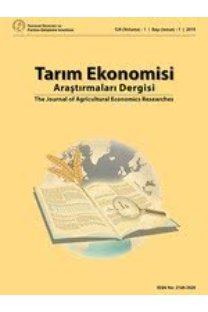Orta Asya Ülkelerinde Buğday Üretiminin Ekonomik Gelişim Seyri
Tarımsal faaliyetler içerisinde yer alan bitkisel üretim, tüm ülkeler için büyük bir değere sahiptir. Bitkisel üretim faaliyetinin alt kolu olan buğday üretim faaliyeti ayrı bir öneme sahiptir. Buğday nüfusun yeterli beslenmesi, sanayi için hammadde oluşturması ve dış satım gelirleri bakımından ayrı bir önem taşımaktadır. Bundan dolayı buğday dünya genelinde geniş bir üretim alanına sahiptir. Buğday üretim faaliyeti ekonomiye sağladığı katkılardan dolayı Orta Asya ekonomileri açısından önem arz etmektedir. Buğday bölge halkının en önemli besin ve gelir kaynağını oluşturmaktadır. Orta Asya bölgesi arazi yapısı, iklimi ve sosyo-ekonomik yapısı nedeniyle bitkisel üretim faaliyeti içinde buğday tarımı için uygun bir yapıya sahiptir. Bu çalışmanın amacı, Orta Asya ülkelerinde mevcut buğday üretiminin genel durumunu belirlemek ve buğdayın ekonomik gelişim seyrini incelemektir. Bu amaç doğrultusunda ikincil verilerden derlenen buğdayın yetiştirildiği alanı, üretim miktarı, verimliliği, ihracat ve ithalat değerleri incelenmiştir. Araştırma sonucunda Orta Asya ülkelerinde buğday veriminin genel olarak düşük seviyelerde olduğu gelişmiş ülkeler ile karşılaştırıldığında dezavantajlı konumda olduğu belirlenmiştir.
Anahtar Kelimeler:
Bitkisel üretim, Buğday üretimi, Orta Asya
Economic Development Trend of Wheat Production in Central Asian Countries
Crop production is a great value for all countries. Wheat production activity, which is the sub branch of crop production, has a special importance. Wheat is a great importance in terms of adequate nutrition of the population, raw material for industry and income from foreign sales. Therefore, wheat has a wide production area worldwide. Wheat production activity is important for Central Asian economies due to its contribution to the economy. Wheat is the most important food and income source for the people of the region. Due to its land structure, climate and socio-economic structure, the Central Asian region has a suitable structure for growing wheat. The aim of this study is to determine the general situation of wheat production in Central Asian countries and to examine the economic development of wheat production. For this purpose, wheat production quantity, productivity, export and import values were examined on the basis of secondary data. As a result of the research, it was determined that the wheat yield in Central Asian countries is generally at low levels and it is in a disadvantageous position when compared to developed countries.
Keywords:
Crop production, Wheat production, Central Asia,
___
- Aldaya, M.M., Munoz, G., Hoekstra, A.Y. (2010). Water footprint of cotton, wheat and rice production in Central Asia, UNESCO-IHE Institute for Water Education, Value of Water Research Report Series No. 41
- Anonim. (2010). Central Asia atlas of natural resources. Asian Development Bank, Manila, Philippines.
- Atar, B. (2017). Gıdamız buğdayın, geçmişten geleceğe yolculuğu. SDÜ Yalvaç Akademi Dergisi, 2(1), 1-12.
- Enghiad, A., Ufer, D., Countryman, A.M., Thilmany, D.D. (2017). An overview of global wheat market fundamentals in an era of climate concerns. International Journal of Agronomy, 17, 1-15.
- FAO. (2009). Essentials of agribusiness (in Russian). Food and Agriculture Organization of The United Nations, https://agris.fao.org/agris-search/search.do?recordID=PH9010429. Erişim: 14.11.2019
- FAO. (2019a). Statistics. Food and Agriculture Organization of The United Nations, http://www.fao.org/statistics/databases/en/ Erişim: 14.11.2019
- FAO. (2019b). Agricultural Outlook 2018-2027. Food and Agriculture Organization of The United Nations, http://www.fao.org/publications/oecd-fao-agricultural-outlook/2018-2027/en/, Erişim: 14.11.2019
- FAO. (2019c). Food Outlook. Food and Agriculture Organization of The United Nations. www.fao.org/publications. Erişim 12.09.2019.
- ITC. (2019). International trade in goods, İnternational Trade Centre, http://www.intracen.org/itc/market-info-tools/statistics-export-product-country/ Erişim: 23.12.2019.
- Kumar, P., Yadava, R.K., Gollen, B., Kumar, S., Verma, R.K., Yadav, S. (2011). Nutritional contents and medicinal properties of wheat: a review. Life Sciences and Medicine Research, 2011, 1-10.
- Lerman, Z., Sedik, D., Yusupov, Y., Stanchin, I., Kazakevich, I. (2016). Wheat production and regional food security in CIS: the case of Belarus, Turkmenistan and Uzbekistan. FAO Regional Office for Europe and Central Asia Policy Studies on Rural Transition, No. 2016-1, Hungary.
- Lioubimtseva, E., Henebry, G.M. (2009). Climate and environmental change in Arid Central Asia: ımpacts, vulnerability and adaptations, Journal of Arid Environments, 73, 963-977.
- Oshakbayev, R. (2012). Export of grain in Kazakhstan. FAO Regional Office for Europe and Central Asia Policy Study, No: 6, Hungary. Peker, K. (2009). Tarım Sektörünün Elazığ Ekonomisinde Yeri ve Gelişme İmkânları İçinde Elazığ İlinin Ekonomik Gelişmesi. Elazığ: İktisadi Araştırmalar Vakfı.
- Serpi, Y., Topal, A., Sade, B., Öğüt, H., Soylu, S., Boyraz, N., Bilgiçli, N., Direk, M. (2011). Buğday raporu. Ulusal Hububat Konseyi, Ankara.
- Spoor, M. (2004). Agricultural restructuring and trends in rural ınequalities in Central Asia: a socio-statistical survey. Civil Society and Social Movements Programme, Paper Number 13, UNRISD, Geneva.
- Syzdykov, R., Aitmambet, K., Dautov, A. (2015). Country Report: Kazakhstan. Analytical Centre of Economic Policy in Agricultural Sector, Kazakhstan.
- USDA. (2019). Kazakhstan grain and feed annual, Foreign Agricultural Service. https://www.fas.usda.gov/data/kazakhstan-grain-and-feed-annual-5, Erişim:23.12.2019 Yu, X., Luo, H., Wang, H., Feil, J.H. (2020). Climate change and agricultural trade in Central Asia: evidence from Kazakhstan. Ecosystem Health and Sustainability, 6 (1), 1-9.
- Yayın Aralığı: Yılda 2 Sayı
- Başlangıç: 2015
- Yayıncı: Tarımsal Ekonomi ve Politika Geliştirme Enstitüsü Müdürlüğü
Sayıdaki Diğer Makaleler
Orta Asya Ülkelerinde Buğday Üretiminin Ekonomik Gelişim Seyri
ARIMA Modeli ile Türkiye Bal Üretim Öngörüsü
Nijerya’da Kasava Üretim Göstergelerinin ARIMA Modeli ile Tahmini ve Gelecek Gıda Arzına Etkisi
Edamisan Stephen IKUEMONISAN, Adeyose Emmanuel AKINBOLA
Suudi Arabistan Krallığında İthal Meyvelerin Talep Esnekliği
Mohammed Sanusi SADIQ, Invinder Paul SINGH, Muhammad Makarfi AHMAD
“Sürü Yönetimi Elemanı Benim” Projesi Kapsamındaki Tarımsal Eğitim Faaliyetlerinin Analizi
Zehra ÇİÇEKGİL, Yener ATASEVEN
Kastamonu İli Merkez İlçesinde Gıda Ürünleri Tercihinde Coğrafi İşaretlerin Etkisi
